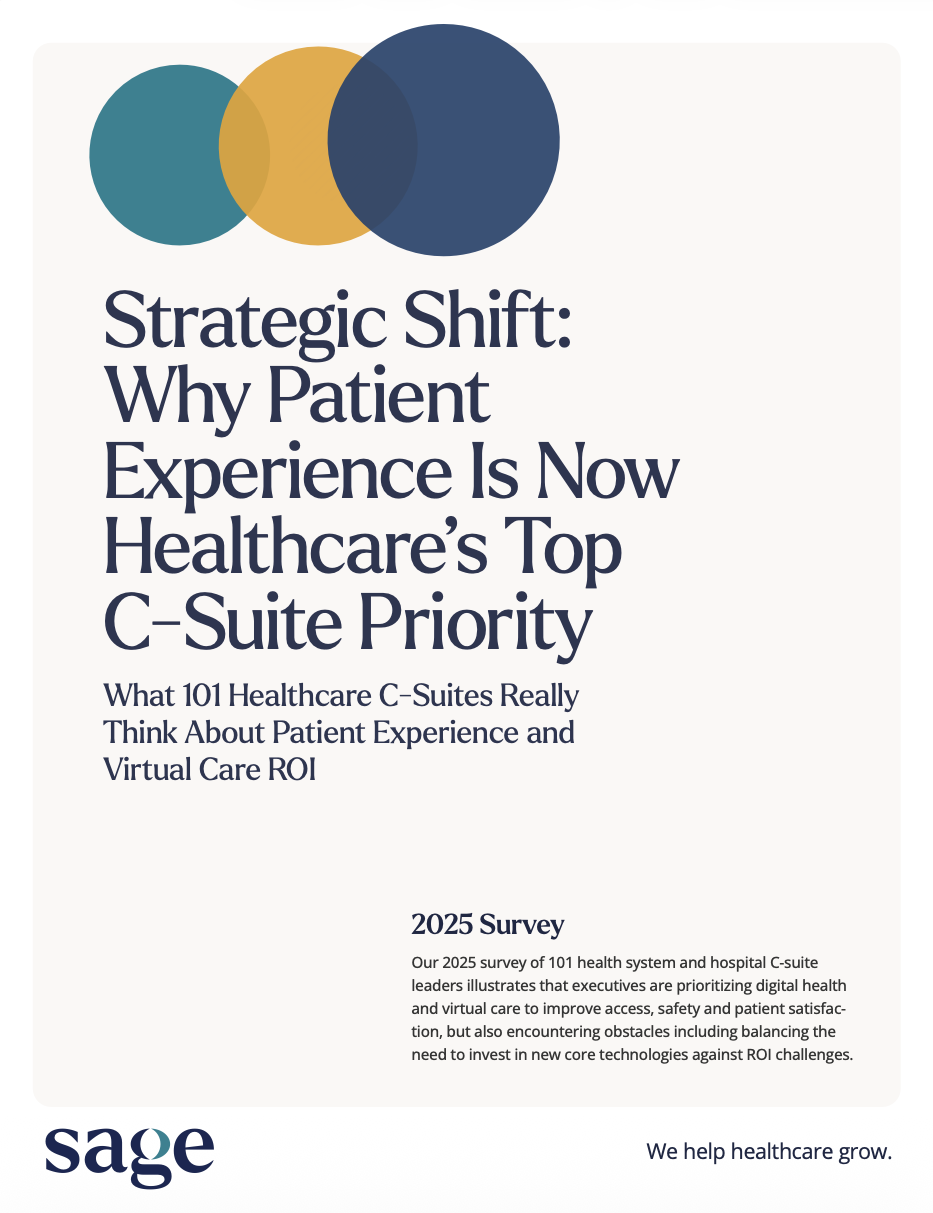I have a confession to make: I’m a HIMSS newbie. Yes, there are still some of us out there —lost in the maze of venues and booths that turned Las Vegas into the Healthcare Hunger Games. I’ve been to HLTH and ViVE many times, but this was not only my first HIMSS but my first as Senior Vice President of Sales for Sage.
The advantage of all these firsts is being able to look at things with Beginner’s Mind — which we should all be doing when it comes to THE topic at HIMSS: AI. Perhaps you’ve heard of it, talked about, thrown some shade at it or proclaimed it the best thing to happen to healthcare since — wait, what was the last best thing that happened to healthcare?
Whether your AI convos have been exhilarating or exhausting, here’s some perspective from what I heard and saw at HIMSS — with key questions, takeaways, and a preview of Sage’s KOL research.
At HIMSS, did the floor reflect the market?
Yes — confusing, crowded, maze-like — just like the healthcare AI market and beyond. But which market? The one with a Dow of 43K or the one now at 40 and falling? The healthcare industry was once immune from market forces, but will it be going forward and what role will AI play now that everyone’s jumping on the bandwagon? As I wandered the halls of HIMSS, I couldn’t help but think:
- What bandwagon are we jumping on?
- What will regulations allow or are the guardrails already gone?
- How real is AI’s promise?
AI is sending shockwaves through systems that are already fragile, healthcare and financial, alike. I would say we’re building the airplane while we’re flying it, but AI is starting to do both with us as passengers — and we all know the state of airline safety these days.
I love it when an AI plan comes together
Answering the questions above will require three things that must happen continually:
- We must look at AI with fresh eyes. The pragmatic, not the shiny object kind. The behemoth of healthcare is still hard to move. Tech is trying but old problems prevent evolution and revolution: Bad data, lack of interoperability, cybersecurity, and (ahem) fax machines.
- We must require AI to deliver value. It’s a shame that healthcare has “value-based” fatigue because value is still lacking and sorely needed. AI must prove it can get us there and do so responsibly at every stage of development. (More in the Sage research preview below.)
- We must understand that AI needs pressure testing. Whatever AI Point.0 we’re now at in healthcare, it’s still very much a rules-based model. Generative AI for patient care must wait and maintain human oversight.
But with things moving fast, how do we tell the difference between AI’s low-hanging fruit and its highest branches? By listening to two of healthcare’s primary stakeholders: providers and payers. After drinking from the HIMSS firehose, I put my thoughts together with Sage’s latest primary market research.
Providers on AI: Cautiously optimistic — Payers: ditto
In our KOL interviews, one provider shared this:
“Technology advancements have been the largest contributing factor in the improvement of healthcare. Industry openness to implement and leverage EMRs to their fullest extent, implement virtual care and more recently, implement AI has created a renewed outlook on care delivery and efficiency.”
This renewed outlook is from low-hanging fruit that simplifies workflows versus complicating them. Providers are excited about using AI to automate administrative tasks like transcription and documentation and create diagnostic imaging efficiencies. There is also optimism for integrating AI with virtual care to improve inpatient workflows and ease bottlenecks, but it’s still early.
If providers are focused on care delivery and efficiency, payers are prioritizing process delivery and efficiency (with the eternal goal of cost reduction). Their low-hanging AI fruit is also automation but for the “management” trifecta — disease, utilization, care — facilitated by much-needed patient education and outreach.
Maybe the best way to sum up how stakeholders feel about AI is that it can help clinicians make better and faster diagnoses, treatment plans, and outreach to patients, and help payers support them in that work. Providers believe that AI is a powerful tool and force multiplier with broad applicability, but not if it makes healthcare more complicated. Payers believe AI can offer significant benefits, not just buzz, but that it’s not yet achieved true intelligence and trustworthiness.
And then there are the regulators. It is not clear how the federal government will oversee AI-supported health tools just yet, according to Julie Barnes at Maverick Health Policy. The Trump administration is developing a new AI Strategic Plan and is starting to centralize tech policy in the White House Office of Science and Technology Policy. It is the state governments that are already reigning in AI developers, but state policy varies widely.
All of this creates a confusing landscape for developers, deployers, and users of health AI tools. #surprisednotsurprised
Can we talk?
Healthcare is hard. If I heard that from one person at HIMSS, I heard it from five — and in the middle of it all was always AI.
For providers and payers to collaborate well in the space, the delivery and efficiency of both care and process must meet. For Big Healthcare and Big Tech to play well in the sandbox too, traditional stakeholders need healthcare-specific vendors that can deliver AI value out of the gate, not incessant rework.
But let’s end on an up note shall we? Yes the HIMSS booths were a maze, but that’s also where the best conversations took place and where this conference stood out: More leadership accessibility on the floor. Senior leaders were there — creating intimate spaces to cut through the Vegas noise and talk about AI in ways that actually mean something for their businesses and their customers.
These are the conversations we need to be having, human to human. Let me hear from you! We’ll let AI transcribe.
P.S. More Sage primary market research with KOL interviews is available in our 2025-2026 C-Suite Report — coming soon to an inbox near you!








